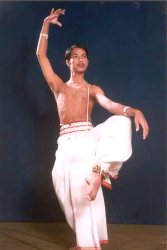
|
 |

|
 |
SPECIALITY AND UNIQUENESS OF ODISSI DANCE by Rahul Acharya, Bhubaneswar e-mail: rahul_acharya@rediffmail.com Aug 2001 Derivations from different mythological logistics has established that dance in whichever form has been refined, modified and twisted with much dedication and perspiration thus forming its separate identity. There is no room left for debate that Uttara Khanda had achieved a special status in Eastern part of India with its separate style of functioning. As per analysis made in Natya Shastra, Udra Magadhi is defined as a special profession in two types of presentations. i.e Udra and Magadhi. But Udra and Magadhi are not two styles; rather it is one, which is today known as Odissi. I strongly believe keeping all aspects at bay, that Odissi is an extension of this system. When analysis is made into the language and cultural history of the eastern part of India, it reveals that till 7th and part of 8th century AD, one type of lifestyle, usage and culture was consistently flowing in this part of the land. Against the backdrop of cultural unity and firmness, no political change in scenario could make any dent to its deep-rooted foundation. Whenever any new idea or novel revolution were found in this religious land, its cream was filtered and given an original shape accordingly by instilling these new perceptions. Through ages Udra Magadhi was developed, disciplined and expanded which ultimately symbolized classical form and status, this fact is not at all disputed. Towards 8th or 9th century AD, eastern part of India was divided into 6 parts as per the prevailing local languages. Regional cultural differences also cropped up. This turbulence swept away Assam, Bengal and Bihar not withstanding its sway in other states. Orissa alone could preserve the Udra Magadhi in the form for which so much toiling, perception and hurdles were surmounted and still continues to sparkle in its rarest sparkle, lucidity and fluidity intact. Now when we study all the Nrutya Shastras of Eastern India, what do we find? Magadha, which is presently known as Bihar, is bereft of any classical dance. Assam, Bengal and Bihar witness only folklores and tribal dances. Manipuri is based on the principles of Vaishnava Dharma. Whoever is privileged to witness it, cannot say that it is different in any form or structure from Udra Magadhi. It can be attributed to the fact that both Meiti and Udra mean the same i.e. formation through symphony. When one dwells on the specialty of this Nrutya Shastra, automatically and sporadically the word "Prabruti" reverberates in the eardrum. Instinct is engraved in the human body and originates from the attitude. A person coming into this domain from a particular geographical background carries with him / her the instincts, which are influenced by the natural life history, ridges and furrows of ambitions, anxiety and happiness as well as sorrows of the demographic conditions and ethnic coverage. These vivid experiences are ramified through plural culture being forerun to be popular culture. That is why it is distinct in nature and form. Udra Magadhi is the epitome of this kind of instinct of the locality with specialty of its own. It is so different from others that one is compelled, even the most critical of critics are conceding special status to it. Whirling style of dancing or Bhaunri in Odissi is another specialty of this system. This style from the inception of Odissi, is channeled through hand, waist, eye, head and legs to depict the theme of the story. Tribals have gained fluency in whirl dancing which is very common to them. This otherwise speaks of the evolution of planet earth. The basic philosophy behind the Mahari Seva in the Jagannath Temple was to perform dance at the time of the Lord's breakfast or the Sakala Dhupa and dinner or the Badashringara Vesha. During this period there was no vocal communication. This too is one of the rare features of Odissi. These Maharis used to follow this type of dance minus music, which was adopted, by demons and human beings as evident from the 56th chapter of Bharata's Natya Shastra. Until the advent of the Vaishnava cult, this musicless dance was the specialty of Odissi. Thus Odissi culture is the inner feeling of human life style and is complimentary to the lucidity, fluency and abundancy.  Rahul Acharya, disciple of Guru Durga Charan Ranbir is doing research on Jagannath Culture and the ritualistic aspect of dance under the able guidance of Shri R N Rathsharma and special guidance from the Gajapati Maharaja of Puri. He is also being trained in the field of Vedas and Shastras, by Shri R N Rathsharma, who himself is an authority on Jagannath Culture. |